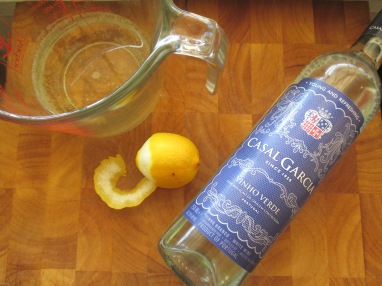Last week I had the pleasure of attending the conference Intoxicating Spaces: Global and Comparative Perspectives and sharing my research on a recipe for “The Ice Cream” that I posted here two years ago. The ice cream recipe is from a manuscript that was compiled and used by Elisabeth Hawar around 1687, and it includes two London addresses. The recipe book is now held at the William Andrews Clark Memorial Library (fMS.1975.003). In my paper, I tried to locate Elisabeth Hawar’s recipe book in the mercantile communities of Shoreditch and Spitalfields in East London at the end of the seventeenth century.
Hawar’s book has another, intriguing London reference: a recipe for “How to make a London Possett.” I’m not sure, exactly, why this posset recipe is specific to London, but it’s certainly another link between Hawar’s manuscript and the city where she lived, cooked, and ate. I didn’t have time to speak about the posset at the conference — there’s always a lot to say about ice cream! — but I wanted to share some thoughts about testing Hawar’s posset recipe here.
I’ve had Hawar’s posset recipe on my list for a long time and even written about it in the introduction to the “Textures” series that Amanda Herbert and I co-edited for The Recipes Project. In Hawar’s “London Possett” recipe, the mixture of cream and eggs form a “cheese” on top of the flavored, spiced, sack. I wanted to know how this cheesy layer would form, what might be texturally pleasing about it, and how it would effect the familiar posset mix of spices and alcohol.
Original Recipe

How to make a London Possett
2x
Take a pint of sack & 12 eggs, beat them very well both
whites & yolkes, then strain them & put the sack & eggs
togather, & sweeten it with sugar & Nutmegg as you
please, & sett it ouer the fire keeping it stirring till it be
scalding hot then take it of the fire & put in a quart
of Creame boyling hott, holding your hand as high as
you can in the pouring of it, then give it a stir &
couer it close with a plate, & let it alone till it be like
Cheese, & if it shoud not come set it on a gentle fire
till it begins to Corn.
A word of warning: As curious as I was about this recipe, my recipe trial didn’t quite work. There were many clumps of eggs in the finished posset, but no pleasant “cheese.” I can think of a number of reasons for the failure of the recipe trial to produce what Hawar describes. I suspect the biggest culprits were my twenty-first century ingredients: modern sherry substituted for seventeenth-century sack, egg size and moisture differences, cream pasteurization and homogenization. I also wonder if a tall thin, cooking pot might have enabled the ingredients to separate differently. Finally, it was a hot day in Philadelphia which may have impacted the ingredients and the finished product.
Updated Recipe
This recipe is halved from the original and did not produce the desired “cheese.” I invite you to use it as a starting point and share the results of your own recipe trials in the comments.
1/2 cup sherry
3 eggs
1 tablespoon sugar
1/8 tablespoon nutmeg, freshly grated
1 cup cream
Beat the eggs together. Add sack, sugar, and nutmeg to the eggs.
Pour this mixture into a medium size pot. Gently heat to body temperature. Do not allow the eggs to cook.
In a separate, smaller pot, boil the cream.
Pour the cream into the egg and sack mix from a high hight.
Cover the posset with a lid and let it cool. A cheesy layer of eggs and cream should form on the top.
Sip and enjoy.























You must be logged in to post a comment.